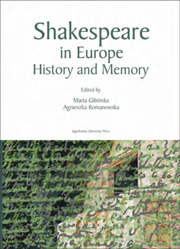Book contents
- Frontmatter
- Contents
- Preface
- Towards a European History of Henry V
- History and Histories
- History and Memory: Criticism and Reception
- History, Memory, and Ideological Appropriation
- Theatre: The Act of Memory and History in the Making
- Shakespeare Remembered by his Stuart Successors: Reflections on the 2005 “Gunpowder Season” at the Swan Theatre in Stratford
- “Who's there?” – Macbeth on the London Stage 2004–2005
- Stillness in Hamlet
- “Blood Sprinkled or Blood Spilt:” the History of Richard II Revisited in the Contemporary Theatre
- The Memory of Architecture: New Thoughts on Reconstructing old Theatres (The Case of the Gdańsk Fencing School)
- Index of Authors
The Memory of Architecture: New Thoughts on Reconstructing old Theatres (The Case of the Gdańsk Fencing School)
from Theatre: The Act of Memory and History in the Making
Published online by Cambridge University Press: 05 September 2014
- Frontmatter
- Contents
- Preface
- Towards a European History of Henry V
- History and Histories
- History and Memory: Criticism and Reception
- History, Memory, and Ideological Appropriation
- Theatre: The Act of Memory and History in the Making
- Shakespeare Remembered by his Stuart Successors: Reflections on the 2005 “Gunpowder Season” at the Swan Theatre in Stratford
- “Who's there?” – Macbeth on the London Stage 2004–2005
- Stillness in Hamlet
- “Blood Sprinkled or Blood Spilt:” the History of Richard II Revisited in the Contemporary Theatre
- The Memory of Architecture: New Thoughts on Reconstructing old Theatres (The Case of the Gdańsk Fencing School)
- Index of Authors
Summary
1. The Wooden “O”
First, let us consider the features of what we usually label as the Elizabethan or thrust stages (usually in opposition to the proscenium arch or “box” stages). We have to make sure we are aware what exactly we are to reconstruct. In our understanding, the Elizabethan and Jacobean playhouses were extreme examples of buildings which, as works of architecture, or perhaps rather, of construction, in themselves had no special significance other than utilitarian: they were places for presenting plays, or sometimes for fencing shows (the Hope theatre also served as a stage for animal fights). To look for deeper, metaphorical or symbolic significance in these theatres or to ascribe them to Renaissance neo-Platonism, astrology or even alchemy, is quite simply an academic abuse. In total, ten original theatres were erected – that is new theatres that were not adaptations of other already existing interiors. However, it ought to be noticed that those buildings were designed and constructed not by architects educated on the writings of Ficino, but by carpenters. Their architectural genesis was not Vitruvius or Teatro Olimpico, but simple amphitheatres designed for animal baiting (of which there were at least six in London before 1576). This is true despite the fact that these theatres “pretended” to be something “better:” the wooden tiring-house façade, a kind of distant echo of the frons scenae, was painted in such a way as to suggest walls of brick, while the columns were “made to look like marble,” as Johannes de Witt recalls.
- Type
- Chapter
- Information
- Shakespeare in EuropeHistory and Memory, pp. 313 - 332Publisher: Jagiellonian University PressPrint publication year: 2008



